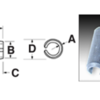good morning all,
I've got #7102 up on stands for some winter attention. She came to me from CA last june.
I'm owner #4. Owner #3 basically just drove the car for a few years, little or no work other than maintainence (always done by others). Owner #2 was a real enthusiast and installed most all of the cars many upgrades: engine, cooling, a/c comp, cabin, etc. Owner #1 was a Ford dealer in Arizona I'm told, who had his dealership dress the car up in her current appearance, a Euro GTS package, 8"/10" wheels, riveted on flares, paint and graphics. The only thing it doesn't have is the vented hood, which I would like to find, or maybe I'll have some vents cut in. That stuff is for next year or whenever it presents itself at the right price.
The engine was rebuilt by Jim Grubbs Motorsports about 20K miles ago. Receipts indicate 9.5:1 pistons, a Crane Boss 351C equivalent cam, upgraded oil pump and oil pump drive and a 10 quart oil pan. She's got a nice set of Jet Hot coated GTS style headers with original tail pipes and mufflers. The heads are the originals I'm sure, they're stamped with the same ID # as the builders plate. in 1974 I think that would mean open chambered. Owner #2 had an Edelbrock Torquer intake and a Holley, both of which were removed after a (lost) battle with the C.A.R.B. police. So, now we've got a fully reconstructed stock set-up in place that runs pretty well actually, but of course, we can't leave that alone.
I'm going to pull the stock intake manifold, EGR stuff and Motorcraft 4300D spreadbore and replace with a Blue Thunder two plane intake manifold and 650 CFM Speed Demon Vacuum secondary carb with an electric choke. Both pieces are new.
A few questions have come up.
1. Am I going to have to remove the distributor to swap the manifolds? Doesn't look like I'll have to but will it make life easier?
2. There are two vacuum senders in the coolant lines, one with two nipples, the other with three, that are related to, I believe, engine idle speed control by ignition advance and retard. Will these controls have any place in my new set up? If not I'm just going remove the vacuum hoses and cover the ports with some little dust caps. I don't see any need to pull out the senders.
3. I think the distributor/ignition system is stock. Tag on the distributor reads OE 01 D9TE 12127 AKA, module is a "Duraspark". I cannot see any #s on the module. It has never acted up on me. Should I be doing any more than basic tune up procedures while it's so nice and accessible?
4. Where does the vacuum advance want to get its signal from? Will that affect my initial ignition timing?
5. Considering 4, what should my initial timing be?
6. What spark plugs shall I start out with? It used to run at just about 180 degrees when fully warmed up.
7. Anything else I should be watching out for?
Thanks in advance,
Larry.
Original Post





